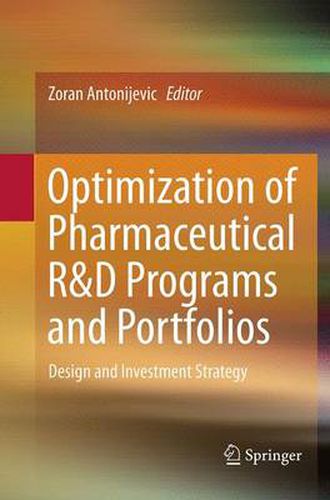Readings Newsletter
Become a Readings Member to make your shopping experience even easier.
Sign in or sign up for free!
You’re not far away from qualifying for FREE standard shipping within Australia
You’ve qualified for FREE standard shipping within Australia
The cart is loading…






This title is printed to order. This book may have been self-published. If so, we cannot guarantee the quality of the content. In the main most books will have gone through the editing process however some may not. We therefore suggest that you be aware of this before ordering this book. If in doubt check either the author or publisher’s details as we are unable to accept any returns unless they are faulty. Please contact us if you have any questions.
Very little has been published on optimization of pharmaceutical portfolios. Moreover, most of published literature is coming from the commercial side, where probability of technical success (PoS) is treated as fixed, and not as a consequence of development strategy or design. In this book there is a strong focus on impact of study design on PoS and ultimately on the value of portfolio. Design options that are discussed in different chapters are dose-selection strategies, adaptive design and enrichment. Some development strategies that are discussed are indication sequencing, optimal number of programs and optimal decision criteria.
This book includes chapters written by authors with very broad backgrounds including financial, clinical, statistical, decision sciences, commercial and regulatory. Many authors have long held executive positions and have been involved with decision making at a product or at a portfolio level. As such, it is expected that this book will attract a very broad audience, including decision makers in pharmaceutical R&D, commercial and financial departments. The intended audience also includes portfolio planners and managers, statisticians, decision scientists and clinicians.
Early chapters describe approaches to portfolio optimization from big Pharma and Venture Capital standpoints. They have stronger focus on finances and processes. Later chapters present selected statistical and decision analysis methods for optimizing drug development programs and portfolios. Some methodological chapters are technical; however, with a few exceptions they require a relatively basic knowledge of statistics by a reader.
$9.00 standard shipping within Australia
FREE standard shipping within Australia for orders over $100.00
Express & International shipping calculated at checkout
This title is printed to order. This book may have been self-published. If so, we cannot guarantee the quality of the content. In the main most books will have gone through the editing process however some may not. We therefore suggest that you be aware of this before ordering this book. If in doubt check either the author or publisher’s details as we are unable to accept any returns unless they are faulty. Please contact us if you have any questions.
Very little has been published on optimization of pharmaceutical portfolios. Moreover, most of published literature is coming from the commercial side, where probability of technical success (PoS) is treated as fixed, and not as a consequence of development strategy or design. In this book there is a strong focus on impact of study design on PoS and ultimately on the value of portfolio. Design options that are discussed in different chapters are dose-selection strategies, adaptive design and enrichment. Some development strategies that are discussed are indication sequencing, optimal number of programs and optimal decision criteria.
This book includes chapters written by authors with very broad backgrounds including financial, clinical, statistical, decision sciences, commercial and regulatory. Many authors have long held executive positions and have been involved with decision making at a product or at a portfolio level. As such, it is expected that this book will attract a very broad audience, including decision makers in pharmaceutical R&D, commercial and financial departments. The intended audience also includes portfolio planners and managers, statisticians, decision scientists and clinicians.
Early chapters describe approaches to portfolio optimization from big Pharma and Venture Capital standpoints. They have stronger focus on finances and processes. Later chapters present selected statistical and decision analysis methods for optimizing drug development programs and portfolios. Some methodological chapters are technical; however, with a few exceptions they require a relatively basic knowledge of statistics by a reader.